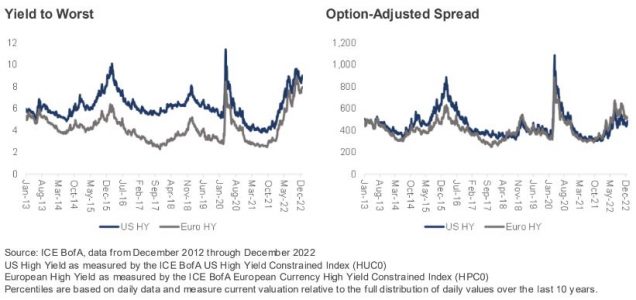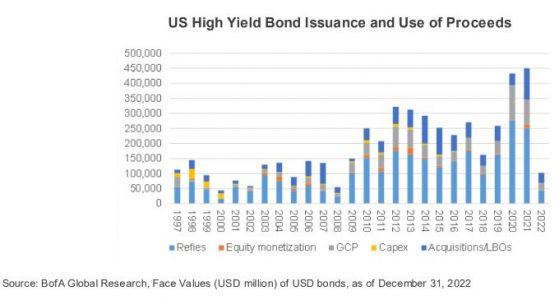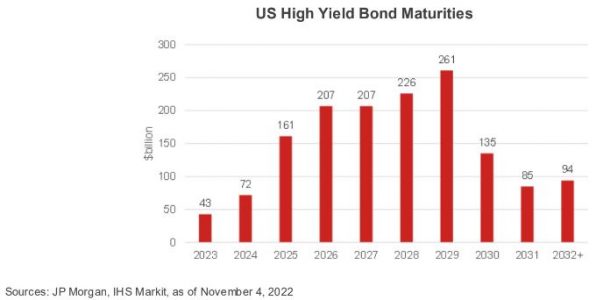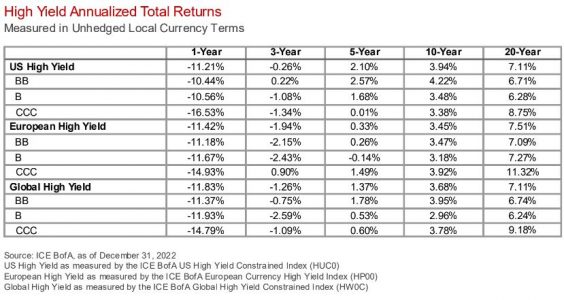Brighter Outlook for High Yield
High yield slumped alongside other asset classes in 2022, with the ICE BofA US High Yield Constrained Index declining -11.21%. Yields increased a hefty 4.7% on the year, rising to 9.0%. Only 37% of the increase in yield was
driven by spread widening, as the market’s option-adjusted spread (OAS) increased a relatively modest 172 bps to a spread of 483 bps.
“Looking forward, we view valuations as very attractive on a yield basis – both US and European high yield are in the cheapest yield decile over the last 10 years. Despite the slowing economy, we are constructive on high yield, forecasting 10-12% returns for the full year 2023. Our spirited outlook is based on the asset class’ relatively healthy fundamentals, highly supportive market technicals, and the attractive yields on offer that help to compensate for the risks of investing in high yield”, reports Nomura Corporate Research and Asset Management INC (NCRAM) in the “High Yield Outlook”.

Mixed Macroeconomic Backdrop
2022 was a year to remember for both risk assets and rates investors, as neither equities nor fixed income provided any respite from the relentless bear market. The S&P 500 declined -18.1%, and the 10-year US Treasury lost -16.3%. Other developed and emerging markets witnessed similarly distressed outcomes for their domestic 60/40 portfolios. Commodities lost their effectiveness as a hedge after an early -2022 rally. WTI crude gained 4.2% on the year, falling -35.1% from its zenith in March.
The year began with the US Fed tacitly acknowledging that surging inflation would not be “transitory.” The Fed and many other global central banks spent 2022 aggressively withdrawing the liquidity they had pumped into their economies during the pandemic. One notable anecdote is the decline in US M2 money supply growth from a shock-and-awe level of 26.8% y/y during the pandemic to 0% annual growth in November 2022, the slowest pace since at least 1959. Market sentiment subsequently shifted from fretting about inflation to worrying about a pending recession. Russia’s invasion of Ukraine added to investors’ consternation in 2022, particularly in Europe, driving up commodity prices and further snarling supply chains.
As the year progressed the global economy softened, sapping demand for commodities and providing firms with breathing room to catch up on backorders and otherwise normalize supply chains, enabling inflation to retreat from peak readings.
As the calendar turns to 2023, says NCRAM, investors remain concerned that the Fed may channel the King of Pop, Michael Jackson, and his “Don’t Stop ‘til You Get Enough” refrain, driving the US economy into recession as a side effect of its efforts to contain inflation.
NCRAM is somewhat more sanguine about the economic outlook. “While we forecast a shallow recession in 2023, we also expect the Fed to pause rate hikes in 1Q23, and the economy to begin its recovery in the second half of the year in anticipation of easier monetary conditions”. According to the outlook, the Fed could begin easing before year-end if inflation and growth continue to react to the 425 bps of tightening plus early stage QT that the Fed implemented in 2022. Markets are unlikely wait for the economic recovery to take hold before rallying, creating a more favorable environment for investing in 2023.
Supportive High Yield Fundamentals
Despite the slowing economy, high yield fundamentals remain relatively sound. US high yield issuers ’ 3Q EBITDA declined -6% sequentially, but rose 17% y/y. High yield companies continue to generate cash flow and are using those resources to prepare for a weaker economy. Leverage in the US high yield market has declined from 5.2x during the pandemic to 3.1x to start 2023.
“The default rate over the last 12 months has held steady at less than 1%. We expect a small increase in defaults as the economy slips into a shallow recession, but given the low leverage carried by high yield issuers and the absence of a market sector under significant stress (e.g. energy in 2015-16 or housing during the financial crisis), we expect the default rate to remain below the 3.2% long-term average. Another reason we are confident that defaults will remain under control is the improvement in credit quality in the US high yield market in recent years. Historically, the high yield market has seen as low as 35% BB-rated bonds, and coming out of the financial crisis, nearly 25% of the market was rated CCC and below.”
Today the market is more than 50% BB, and only about 10% CCC. High quality issuers are generally better positioned to withstand a recession.
Muscular Market Technicals
High yield technicals are very robust, according to NCRAM’s outlook. The US high yield market shrank by nearly $200 billion of market cap in 2022. Calls, tenders, and maturities totaled close to $200 billion for the year. More than $100 billion of high yield bonds were upgraded to investment grade, countered by less than $10 billion of investment grade that was downgraded to high yield. This means that close to $300 billion left the high yield market in 2022 vs. just over $100 billion of new high yield issuance. The nearly $200 billion decline in high yield
bonds outstanding (excluding secondary market buybacks by high yield issuers) is more than 10% of total US high yield market cap (market size is just shy of $1.5 trillion).
“We expect the rising star trend to continue in 2023, as large issuers such as Occidental Petroleum and
Ford could potentially ascend to investment grade. High yield issuers were able to avoid tapping the market in adverse conditions in 2022, because much of the debt stock that would have come due last year was refinanced in the heavy issuance years of 2020-21. There are few high yield bonds maturing before 2025, and approximately 80% of high yield issuers have no bond maturities in the next 2 years, another reason we are confident that defaults will avoid a spike in 2023.”


Attractive Entry Point
The yield to worst for both US and European high yield is quite generous relative to recent history, even if US high yield is not overly cheap on a spread basis. “We believe the yields on offer, along with the previously described fundamental and technical backdrop, support our forecast of 10-12% high yield returns in 2023”, says NCRAM.
JP Morgan Research calculates that over the last 37 years, when investors have put money to work in US high yield with yields of 8-9%, the median 12-month forward return was 11.4%. Given the improved credit quality profile of the market, one would expect investors to demand a lower risk premium to hold high yield.
Thus, NCRAM estimates that US spreads look more attractive relative to history on a quality-adjusted basis. Also note that average high yield bond prices in both the US and Europe are trading close to their deepest discounts in
the last decade, improving the risk-reward ratio for an asset that (if all goes well) matures at par.
NCRAM’s total return forecast assumes the US will lapse into a mild recession, but the high yield market will be able to ride out the slowdown. “Even if our growth forecast is too optimistic and the recession is more painful than expected, rapidly declining US Treasury yields would counter-balance high yield spread widening. With carry around 9%, we believe high yield will generate positive returns even if the depth of the recession surprises to the negative side”, concludes the NCRAM’s outlook.

This document is prepared by Nomura Corporate Research and Asset Management Inc. (NCRAM) and is for informational purposes on ly. All information contained in this document is proprietary and confidential to NCRAM. All opinions and estimates included herein constitute NCRAM’s judgment, unless stated otherwise, as of this date and are subject to change without notice. There can be no assurance nor is there any guarantee, implied or otherw ise, that opinions related to forecasts will be met. Certain information contained herein is obtained from various secondary sources that are believed to be reliable, how ever, NCRAM does not guarantee its accuracy and such information m ay be incomplete or condensed. Historical investment performance is no guarantee of future results. There is a risk of loss. Strategy performance references are based on gross of fees performance.
Certain information contained in this document contains forw ard-looking statements including future-oriented financial information and financial forecasts under applicable securities laws (collectively referred to herein as forward-looking statements). Except for statements of historical fact, information contained herein constitutes forward-looking statements. Although NCRAM believes that the expectations reflected in such forward-looking statements are based on reasonable assumptions, it can give no assurance that forward-looking statements will prove to be accurate. These statements are not guarantees of future performance and undue reliance should not be placed on them. Forward-looking information is subject to certain risks, trends, and uncertainties that could cause actual performance and financial results in future periods to differ materially from those projected. NCRAM undertakes no obligation to update forw ard-looking statements if circumstances or NCRAM’s estimates or opinions should change.
The information presented herein, including market forecasts, is not intended to suggest any correlation betw een the markets or indices discussed and the investment strategies managed by NCRAM. The information is intended solely to provide NCRAM’s opinion on market behavior in response to specific market influences.
This document is intended for the use of the person to w hom it is delivered. Neither this document nor any part hereof may be reproduced, transmitted or redistributed w ithout the prior w ritten authorization of NCRAM. Further, this document is not to be construed as investment advice, or as an offer to buy or sell any security, or the solicitation of an offer to buy or sell any security. Any reproduction, transmittal or redistri-
bution of its contents may constitute a violation of the U.S. federal securities laws.
An investment in high yield instruments involves special considerations and certain risks, including risk of default and price volatility, and such securities are regarded as being predominantly speculative as to the issuer’s ability to make payments of principal and interest.
A copy of NCRAM’s Code of Ethics and its Part 2A of Form ADV, are available upon request by contacting NCRAM ’s Chief Compliance Officer via e-mail at Compliance@nomura-asset.com or via postal mail request at Nomura Corporate Research and Asset Management Inc., Worldwide Plaza, 309 West 49th Street, Compliance Department, 9th Floor, Attn: Chief Compliance Officer, New York, NY 10019 -7316.
The view s and estimates expressed in this material represent the opinions of NCRAM and are subject to change without notice and are not intended as a forecast or guarantee of future results. Such opinions are statements of financial market trends based on current market conditions. The views and strategies described may not be suitable for all investors. This material has been prepared for informat ional purposes only, and is not intended to provided, and should not be relied upon as legal or tax advice.





 By Fórmate a Fondo
By Fórmate a Fondo